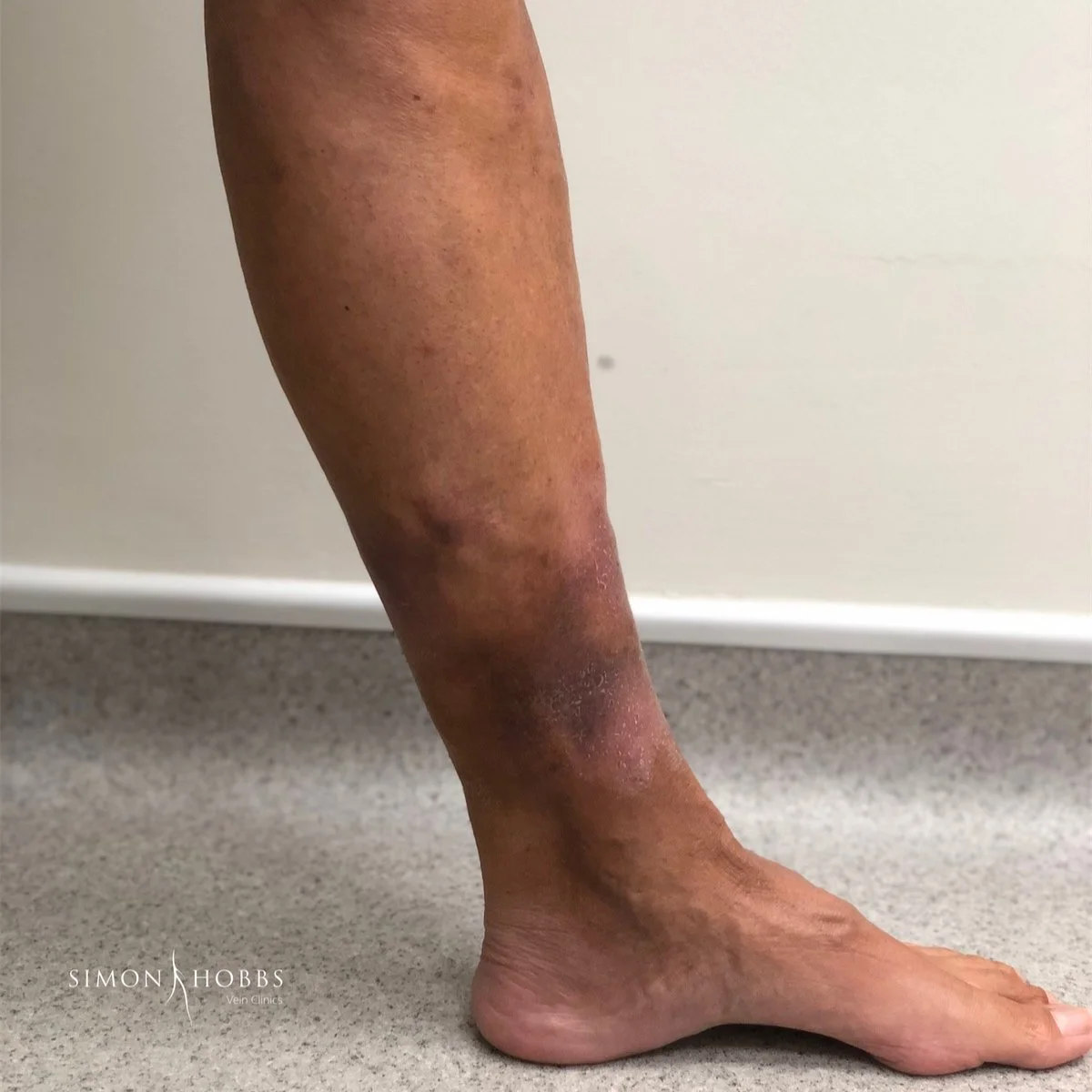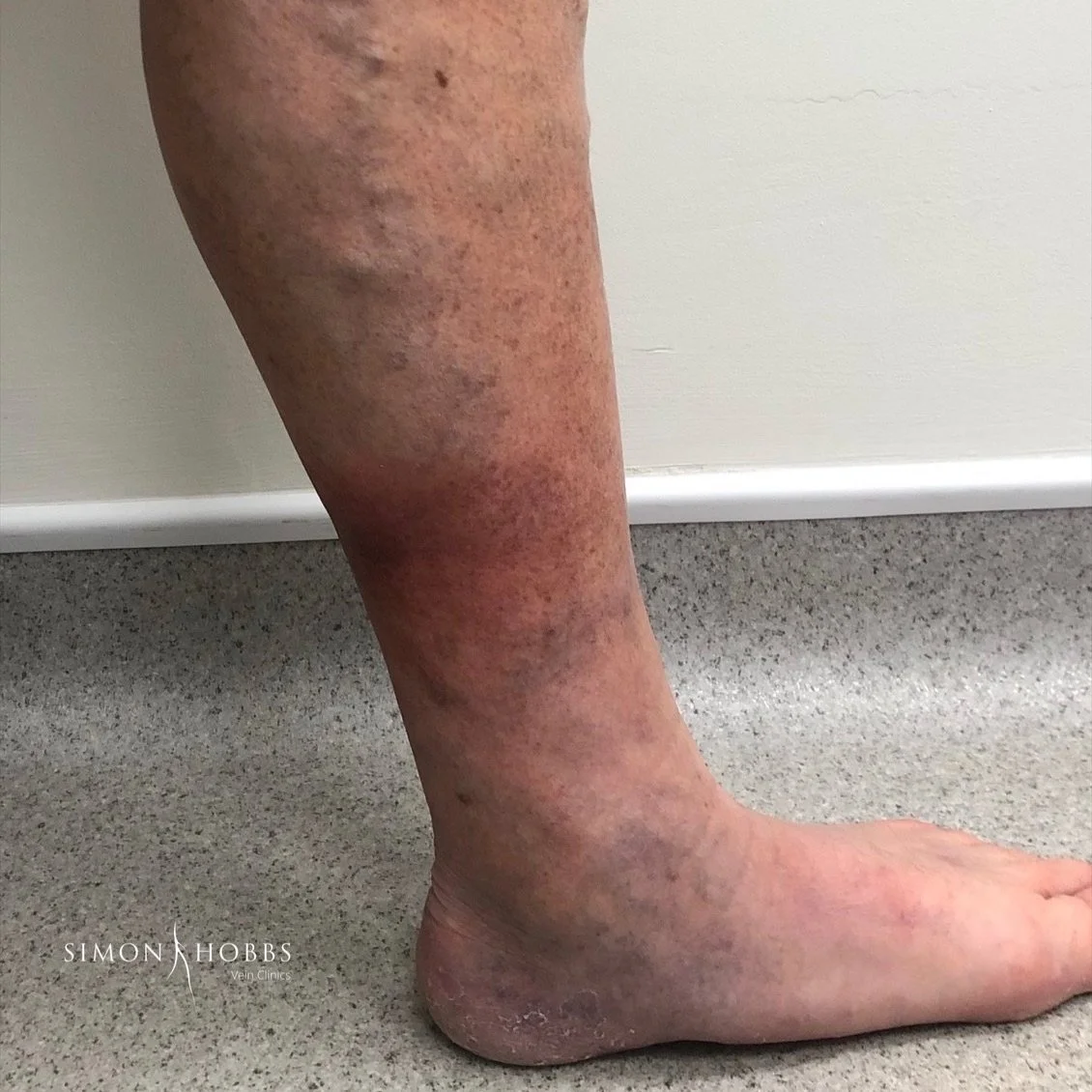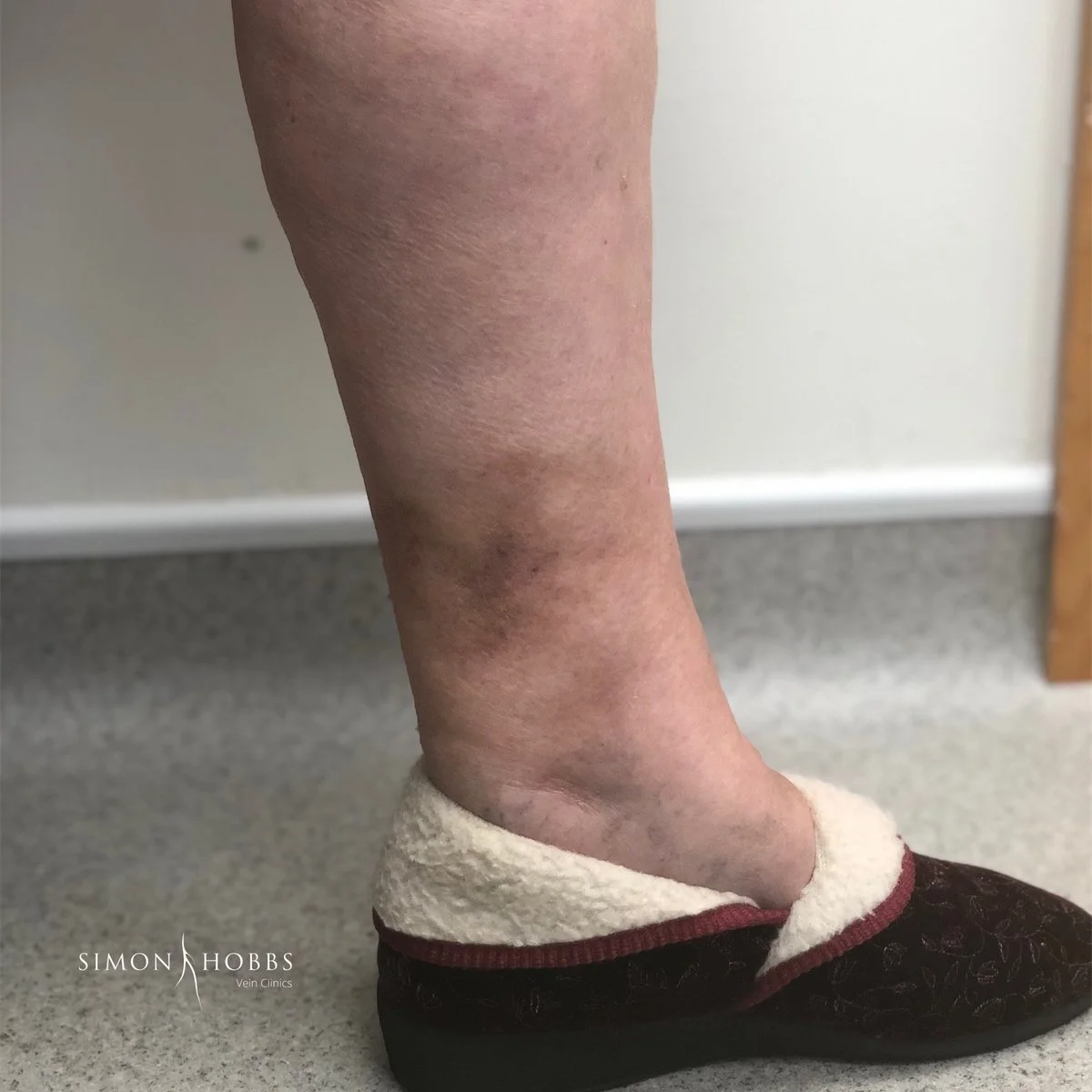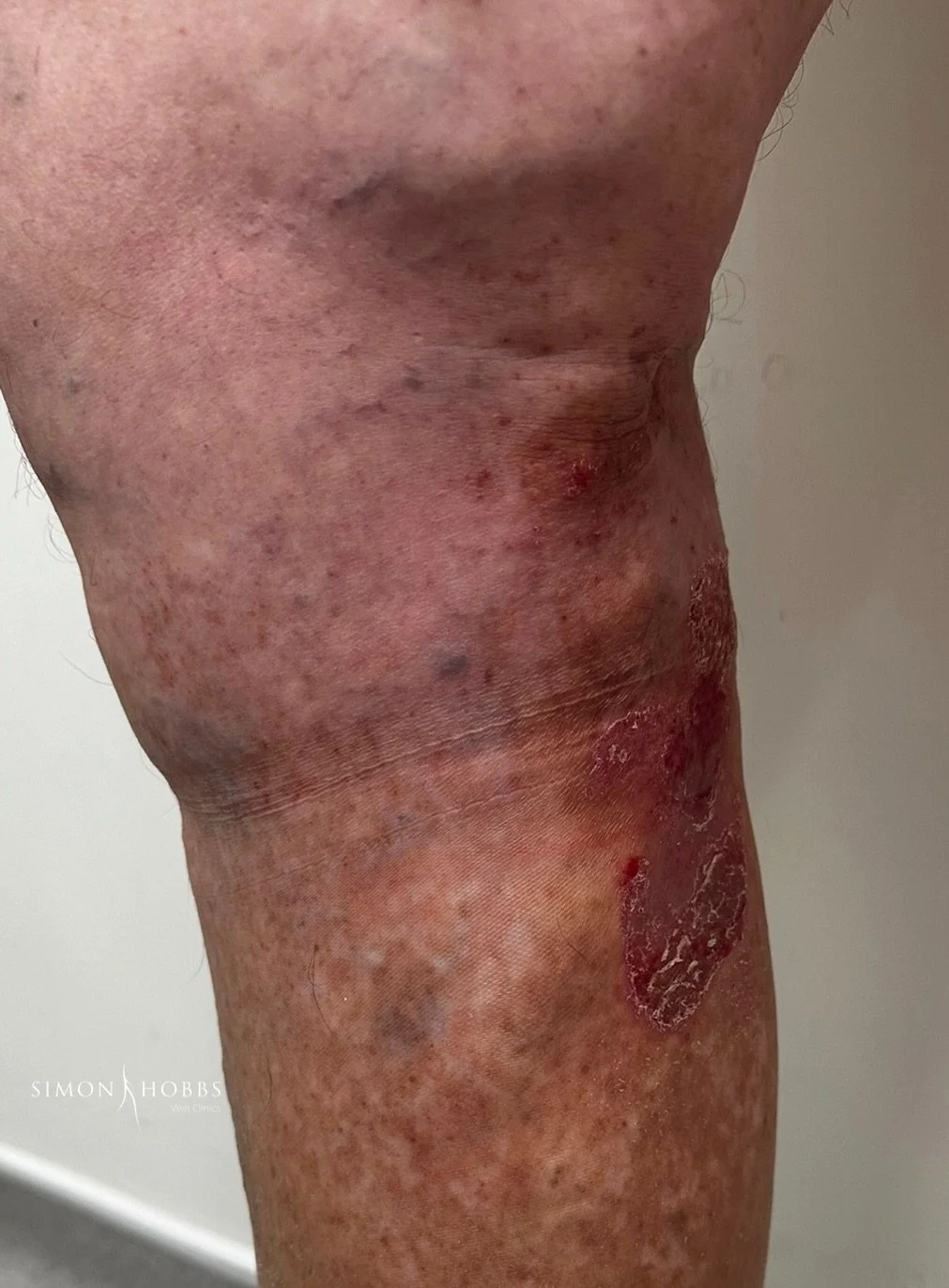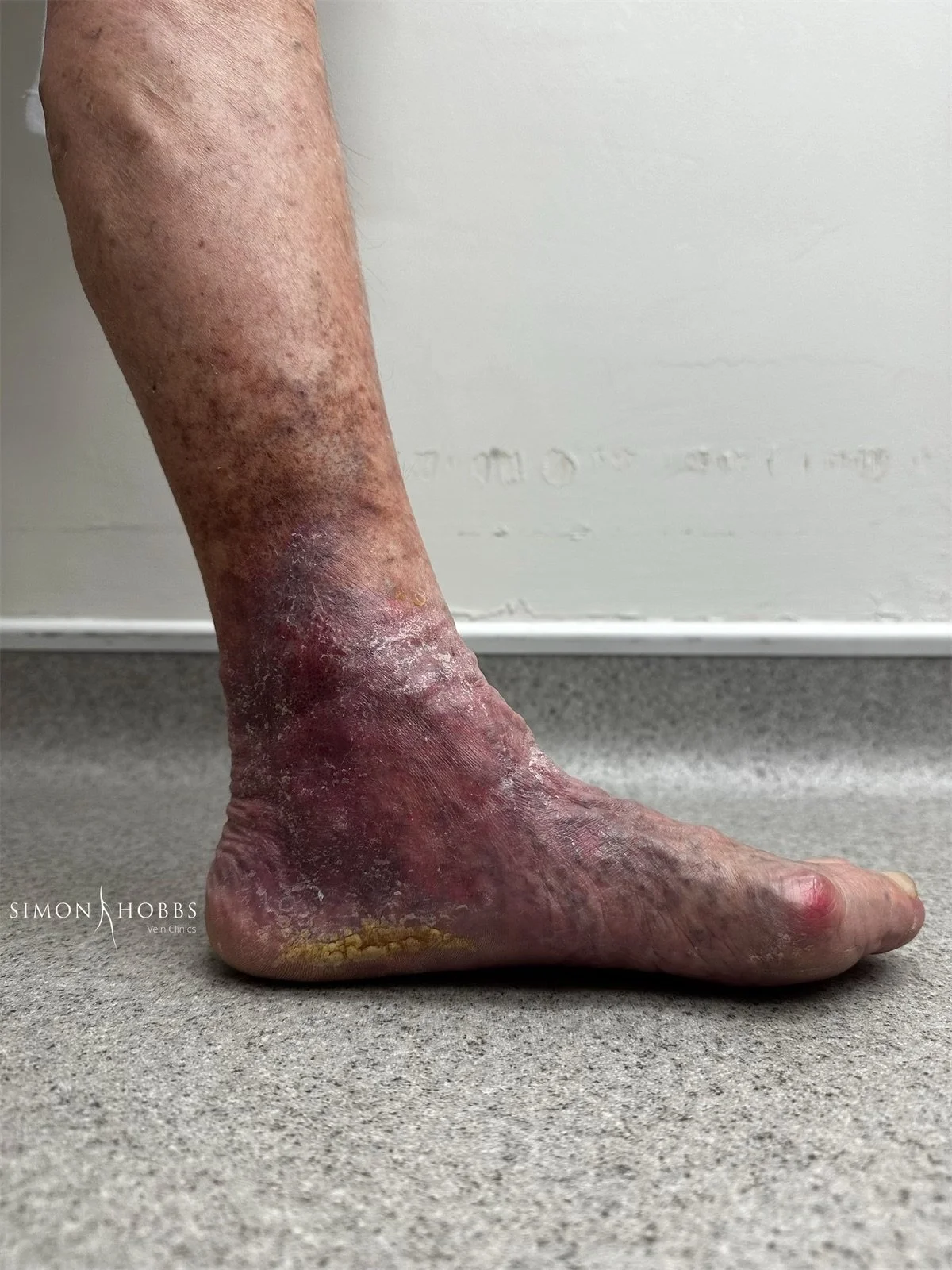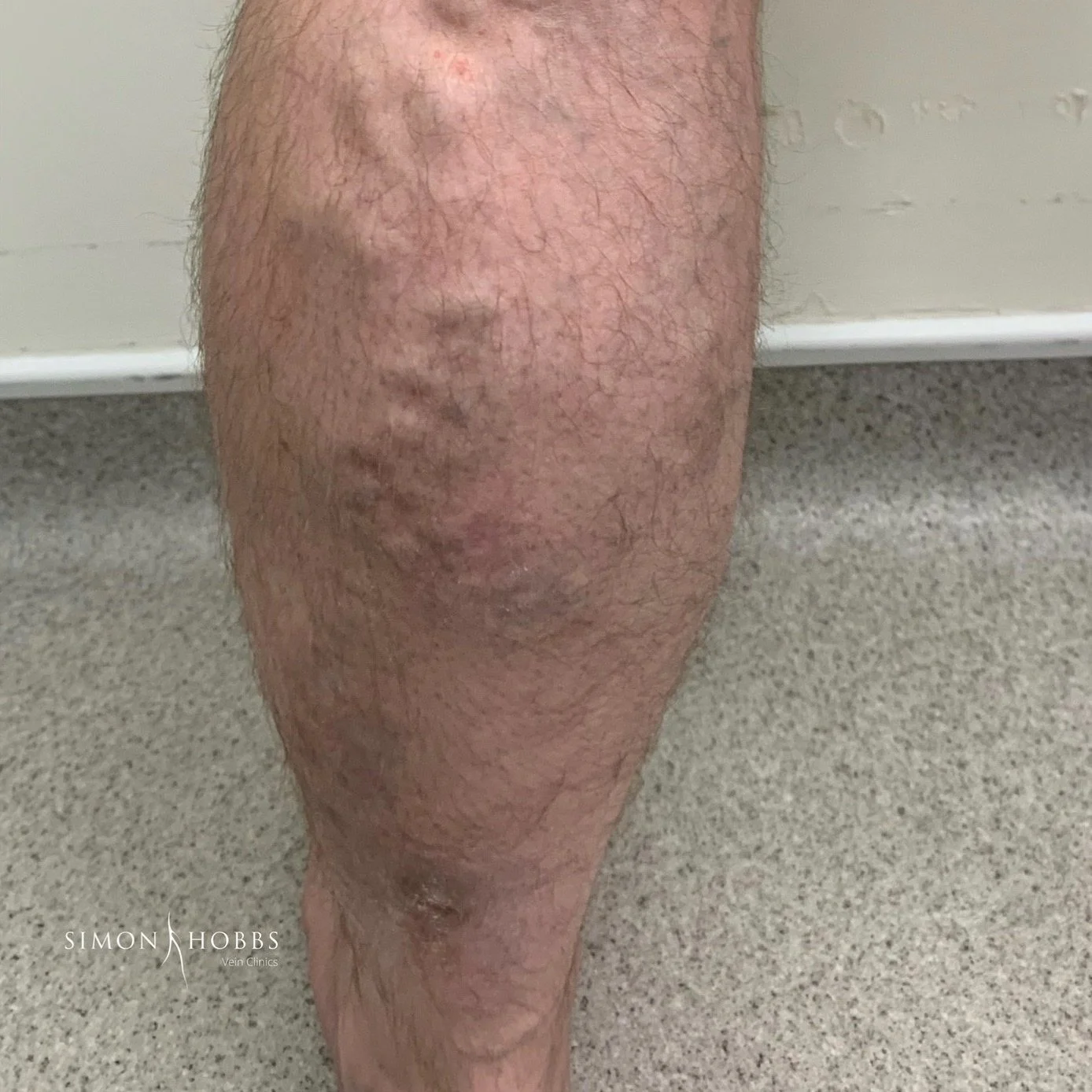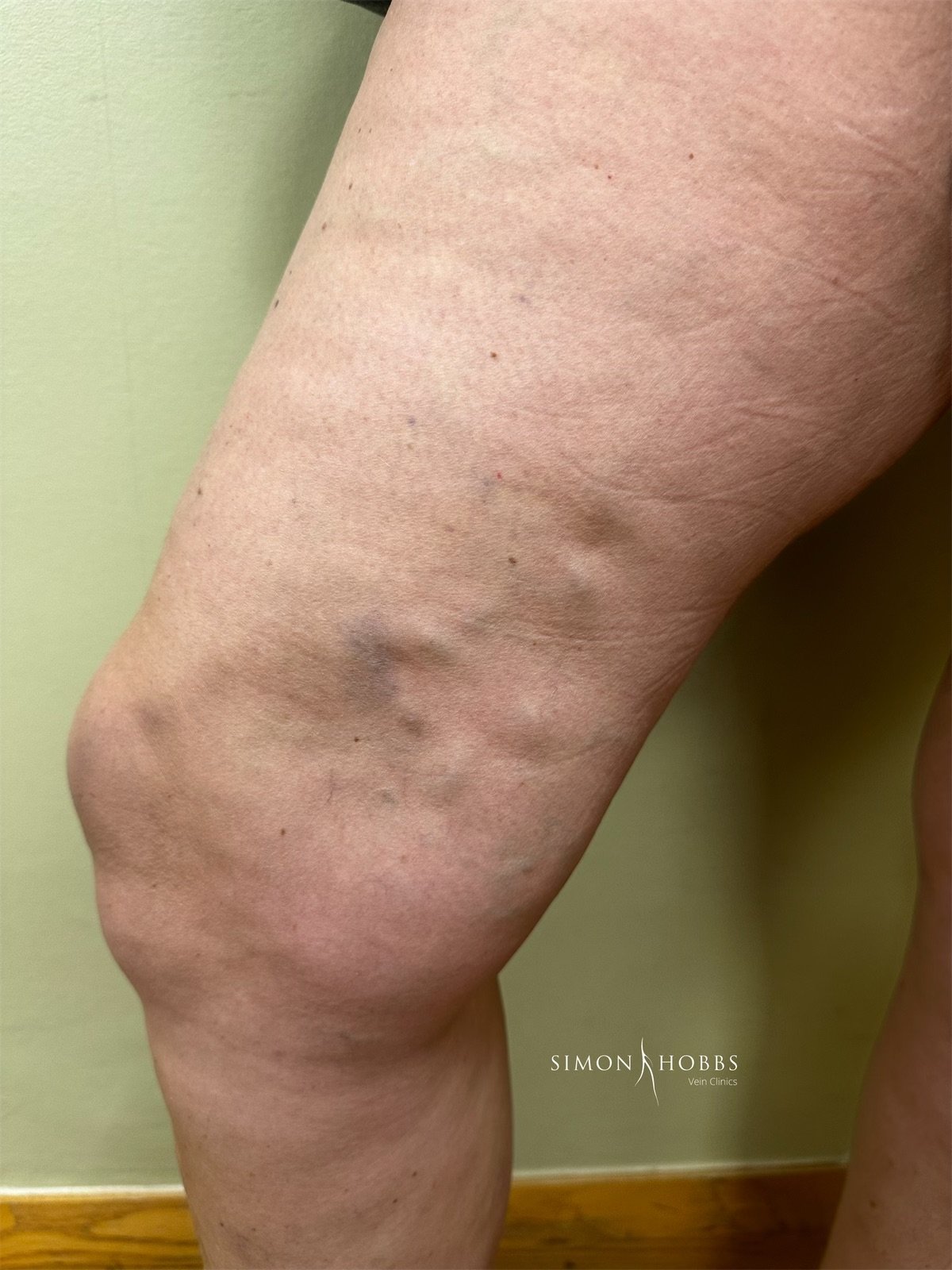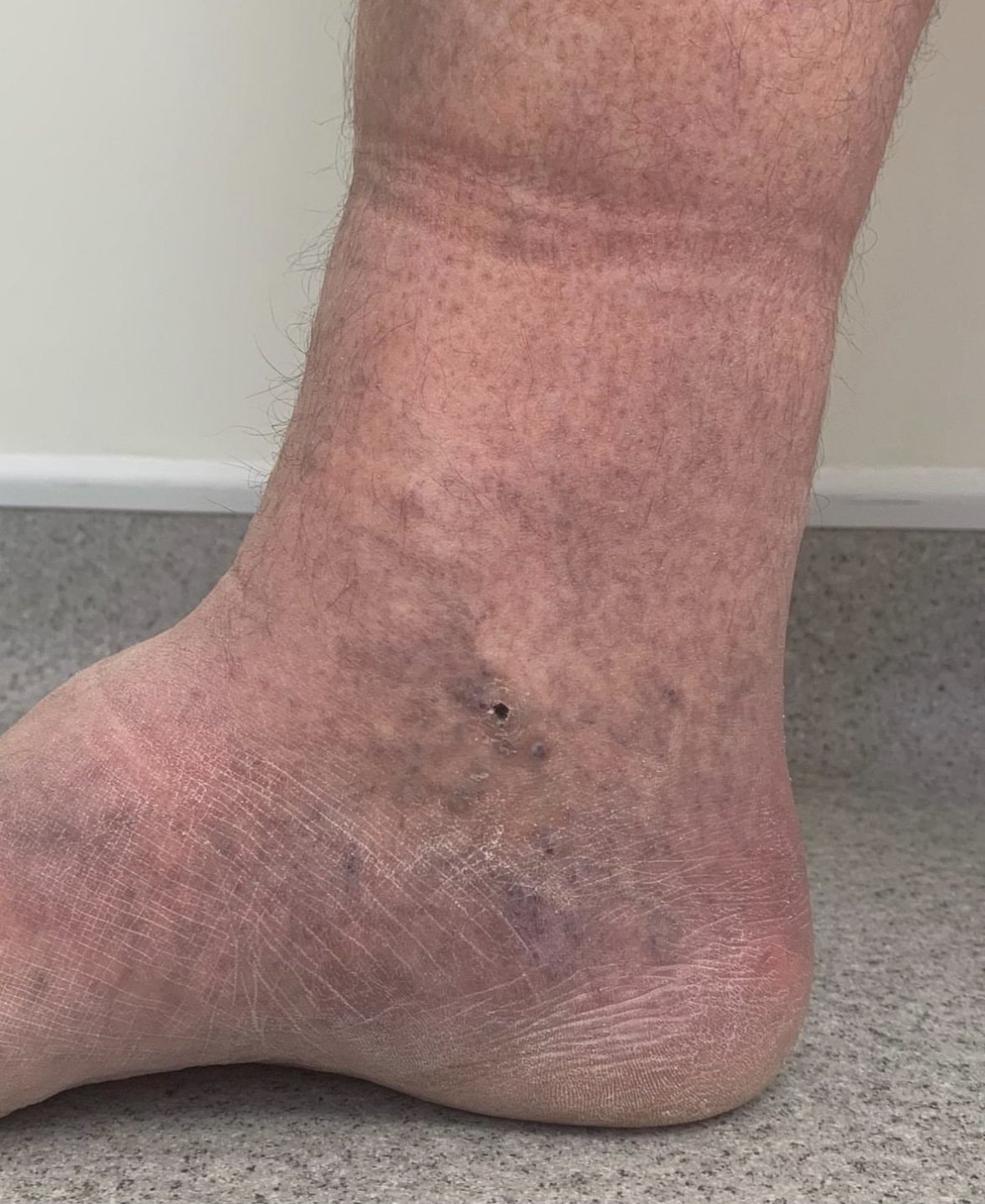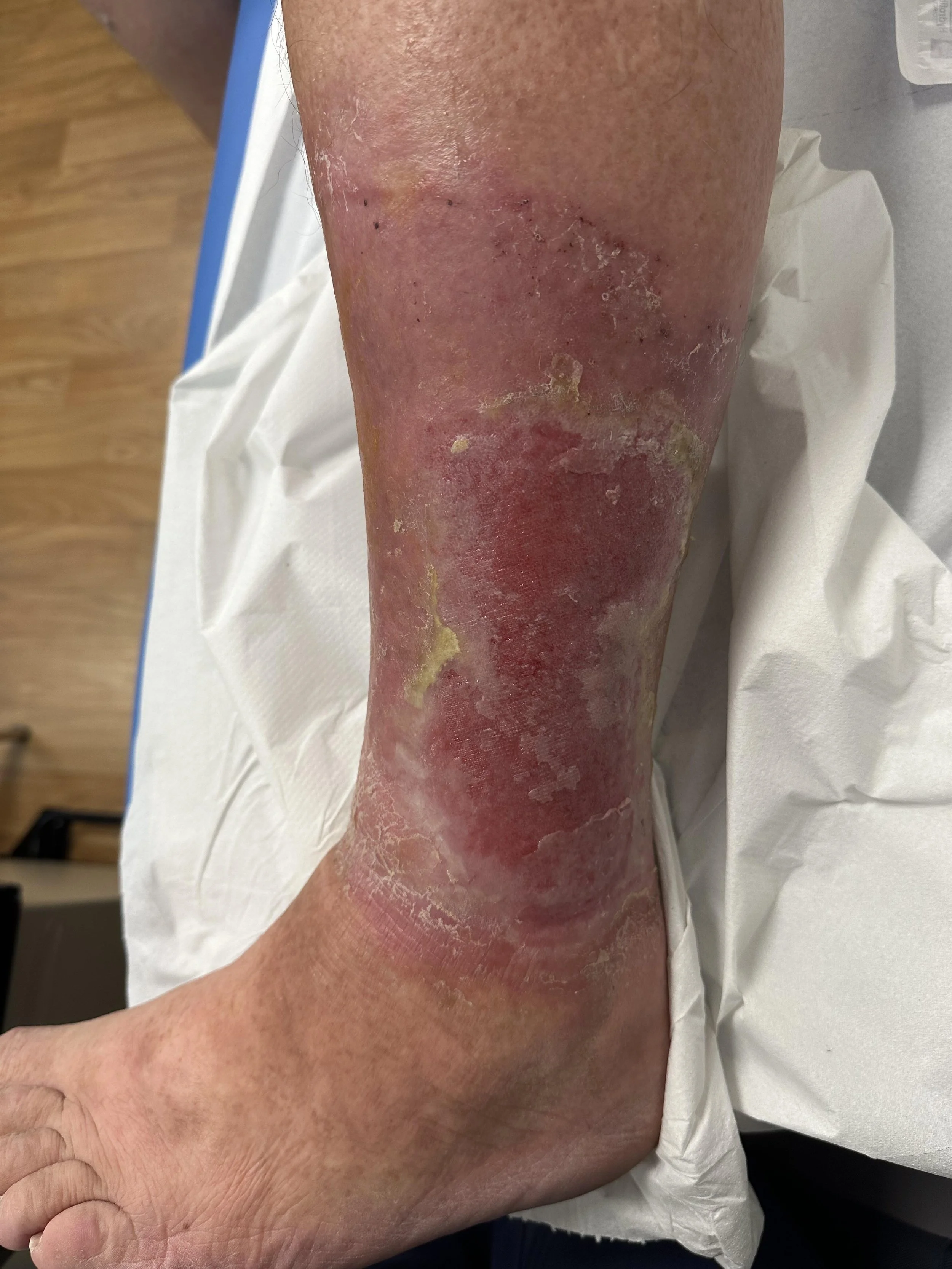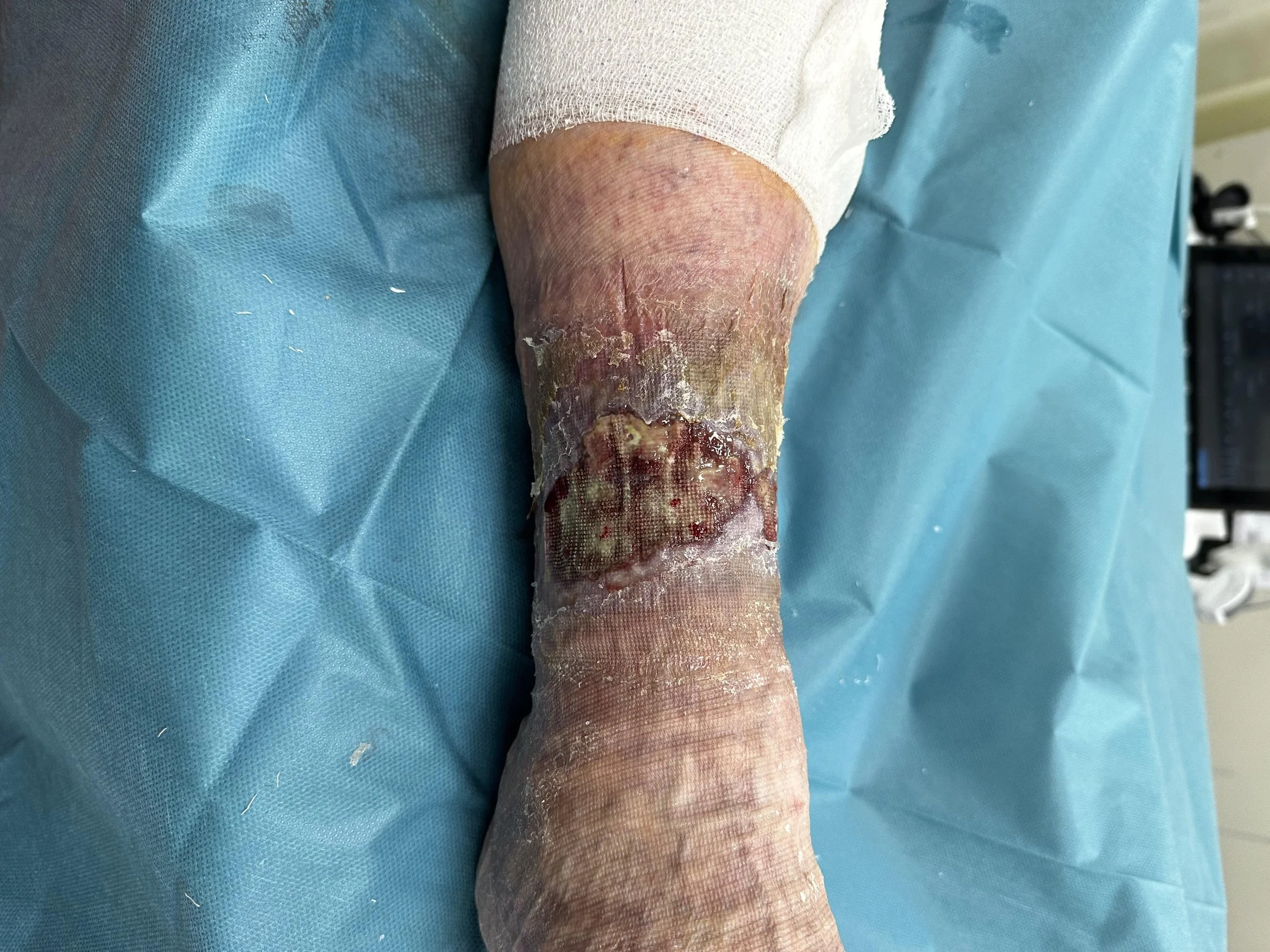
Vein Complications: Knowing the Risks
Varicose Veins Risk:
1 in 10 people develop skin change and 1 in 30 develop leg ulcers
Varicose Veins can cause significant health problems
Whilst varicose veins in many people are predominantly a cosmetic problems, as we have discussed previously, in many people they can also cause quite troublesome symptoms.
However, if untreated, varicose veins will gradually deteriorate over time with worsening appearance and symptoms but can also result in more serious problems. These risk of problems occurring increases with the length of time that veins are present.
Click on the links to found out more about vein complications.
The medical term for skin staining due to venous disease is lipodermatosclerosis
Skin Staining
What is skin staining?
The photos below show some examples of the skin staining or hyperpigmentation that can occur in patients with long-standing varicose veins. Typically the area affected is the region just above the ankle on the inner aspect of the leg although in severe cases it can affect the whole circumference of the leg. The skin usually feels thickened and can be quite tender. Skin staining varies in colour from dark brown to pale pink and may be associated with dry skin. As in is the case in the 1st photograph, skin staining can occur without any significant varicose veins and may well represent reflux in the superficial veins that is only detectable with an ultrasound scan.
What causes skin staining?
Skin staining is a result of the high pressure in the veins due to the failure of the one way valves. This pressure is highest at the ankle which is why it is uncommon to see staining above the knee. The staining is a result of the deposition of iron pigments (haemosiderin) from red blood cell breakdown in the soft tissues which gives the typical rust coloured appearance. There is associated chronic inflammation that can leave the area tender and itchy and results in thickening and scarring of the tissues which can result in ulcer formation.
How is skin staining treated?
Skin staining is due to underlying venous reflux until proven otherwise. The most important test therefore is a venous ultrasound scan. If reflux is identified then treatment of the venous problem is highly recommended to prevent progression and reduce the risk of ulcer formation. We also recommend the wearing of a medical grade compression stocking.
Will skin staining improve following treatment?
The damage to the soft tissues and the skin is in most cases permanent but once the underlying vein problem is treated the inflammation settles and the tissues become softer and the skin staining fades. Failure to treat the underlying problems however will generally lead to worsening problems.
Venous eczema is an inflammatory skin condition caused by high pressure in the leg veins
Venous Eczema
What is venous eczema?
Venous eczema, also known as gravitational or stasis dermatitis, is a skin condition that typically occurs in the lower legs due to high pressure in the veins. It is commonly associated with chronic venous insufficiency, causing symptoms like itching, redness, swelling, and the development of discoloured dry patches on the skin. Venous eczema is typically found around the ankle area but may also overlie varicose veins.
What causes venous eczema?
The increased pressure in the veins due to chronic venous insufficiency results in fluid leakage into the surrounding tissues resulting in an inflammatory reaction in the skin. This leads to the itchy dry skin that people suffer from.
What are the risks of venous eczema?
In addition to being sore and uncomfortable, venous eczema can leave visible scarring on the leg. Scratching the area may also introduce infection into the leg requiring antibiotics and if left untreated there is a risk of it developing into a venous ulcer.
How is is venous eczema managed?
All eczema around the ankle and lower leg should be considered as venous eczema until proven otherwise. Investigation involves a careful ultrasound examination of the leg to assess all the veins in the area. Effective management involves addressing the underlying venous issues and promoting good skin health. The area should be moisturised regularly and there may be some benefit to steroid creams in the short term to help reduce the inflammation. Steroid creams should not be used for prolonged periods as they can lead to thinning of the skin. Compression hosiery is recommended but the only way to effectively treat venous eczema is to deal with the underlying vein problems with minimally invasive vein treatments such as radiofrequency ablation or foam sclerotherapy.
Thrombophlebitis is a painful condition that is often misdiagnosed as infection
What is thrombophlebitis?
Thrombophlebitis (or phlebitis) is a painful condition due to clot forming within varicose veins in the leg. It usually comes on quite suddenly. There is localised pain and tenderness overlying a varicose vein which becomes hard and inflamed. The skin around this area often looks red and swollen as in the picture below. Sometimes you can feel a bit shivery and it is not common for this to be diagnosed as an infection in the leg and for antibiotics to be prescribed.
What causes thrombophlebitis?
Named after a German physician, Virchow’s triad, describes the 3 most common categories of factors that are thought to contribute to thrombosis or clotting. These are: damage or dysfunction of a vein; stagnant blood flow; or an underlying tendency for the blood to clot. Varicose veins fulfil 2 of these criteria as they are, by definition, dysfunctional veins. Furthermore, due to their size and areas of dilatation, the blood flow in the veins is much more sluggish, particularly when sitting for long periods, such as on a long journey which makes it more likely for clotting to occur in the vein, resulting in thrombophlebitis.
Is thrombophlebitis dangerous?
Small localised areas of phlebitis, whilst causing pain and discomfort, do not usually cause serious medical problems. More significant episodes of phlebitis, particularly if they affect thigh veins can progress to deep vein thrombosis (DVT) if the clot from the superficial veins extends into the deep venous system. As discussed below, DVTs can cause serious and longstanding leg problems and if clot were to travel to the lungs this can result in a fatal pulmonary embolus (PE). Thrombophlebitis can on occasion be the first presentation of conditions that increase the likelihood of blood clotting such as thrombophilia or cancer.
How is thrombophlebitis treated?
If you have an episode of thrombophlebitis it is important to see a vein specialist for an accurate diagnosis and a scan to exclude underlying problems including DVT. Immediate treatment is focused on settling down the acute symptoms. Ice packs and anti-inflammatory medication such as Ibuprofen can be helpful. Once the tenderness has improved you may find some benefit in wearing a compression stocking. The acute pain usually settles in a few days but tenderness and lumpiness can last for several weeks. Blood thinning medication is not usually needed for mild cases but where there is concern that the phlebitis might progress to a DVT a course of blood thinning medication is advised. A venous ultrasound scan will help to determine if that is required. Ultimately, if you have suffered from an episode of phlebitis, it is strongly recommend to have your leg veins assessed to establish if treatment is required to prevent further episodes from occurring.
Thrombophlebitis
Varicose veins are associated with a significantly increased risk of DVT
Deep Vein Thrombosis (DVT)
Varicose veins and risk of DVT
There is a significant association between having varicose veins and the risk of developing a deep vein thrombosis. Many large-scale studies have identified that there is somewhere between a 5-times and 9-times increased risk of developing a DVT if you have varicose veins compared to the normal population without varicose veins.
What are the symptoms of a DVT?
Deep vein thrombosis (DVT) symptoms usually start quite suddenly. Symptoms can include swelling, pain, and tenderness, usually in the calf of one leg. Walking is often uncomfortable. If clot breaks off and travels to the lungs (know as a pulmonary embolus or PE) then this can present with sudden onset shortness of breath, chest pain that is worse when you breathe in or sometimes coughing up blood. If you suspect you have a DVT or PE, seek medical attention promptly.
How is a DVT diagnosed?
If a DVT is suspected then a blood test called a D-dimer can be performed - if this test is negative then the likelihood of a DVT is low. A raised D-dimer level can occur in other conditions (eg it is raised following recent surgery) and therefore on its own cannot make the diagnosis of a DVT. If the D-dimer levels are raised, or if there is a strong clinical suspicion then the test of choice is a venous duplex ultrasound. This assesses the deeper veins in the leg and will detect if a blood clot is present.
How is a DVT treated?
If you are diagnosed with a DVT you will need to take blood thinners - either in the form of a daily injection or a tablet. Depending on the severity of the DVT this may be for a period of 3 to 6 months. Some patients who have significant risk factors or have had recurrent episodes many need life-long treatment. Wearing of compression hosiery following a DVT is usually recommended.
What are the risks of a DVT?
Blood clot in the deep veins can block the veins permanently or damage the delicate valves in the veins stopping them from working properly. This can lead to a condition called post-thrombotic syndrome which can cause chronic leg swelling and pain, development of discoloured areas on the skin and an increased risk of ulceration.
If clot travels from the veg to the lungs via the blood stream a pulmonary embolus occurs. This is a serious condition that can be fatal if untreated. PEs can cause chronic shortness of breath and puts a strain on the normal function of the heart.
Leg swelling is serious and can indicate underlying problems - a simple ultrasound can exclude vein problems as the cause
How does venous disease cause leg swelling?
Most cases of leg swelling, particularly under the age of 50 are due to problems with the veins. The high pressure at the ankle caused by leaky valves in the veins results in fluid leaking from the vessels into the soft tissues. This swelling, also called venous oedema, tends to worsen over the course of the day, particularly after periods of standing or sitting and typically improves overnight when the legs are elevated in bed with most of the swelling gone by the morning. Swelling is usually first noticed by a line of indentation caused by your socks in the evening or puffiness around the ankle. If treated early this swelling often fully resolves. If left untreated however, swelling can become more chronic meaning that the ankle never returns back to its normal size, even after elevation.
What are the risks of leg swelling?
Aside from making the leg uncomfortable or heavy, excess fluid in the leg can make you more susceptible to developing infection or cellulitis. The fluid is a good breeding ground for bacteria which can enter through cuts or scratches. Episodes of infection can damage the lymphatic system which can result in worsening swelling that may become chronic or permanent.
Are there any other causes of leg swelling?
Many medical conditions can lead to leg swelling. Damage to the lymphatic system causes lymphoedema. This is more likely to affect the foot, toes and ankle whereas venous leg swelling usually spares the foot. Sometimes leg swelling can however be due to a combination of lymphatic and venous problems. Being overweight is also a common cause of leg swelling as this can cause compression of the veins in the groin leading to high pressure in the veins lower down the leg even in the absence of underlying vein problems.
Sudden onset leg swelling associated with pain needs urgent medical evaluation as this could signal a blood clot or deep vein thrombosis (DVT).
In older age groups, leg swelling may be due to underlying heart or kidney conditions. These conditions are often associated with the build up of fluid elsewhere in the body so you may have other symptoms such as shortness of breath.
How is leg swelling managed?
It is important that all cases of leg swelling are properly investigated. Unless there are known heart or kidney problems, an ultrasound scan of the veins is probably the most useful investigation. If underlying venous reflux is identified then a minimally invasive treatment such as endothermal ablation of foam sclerotherapy is usually advised. Early treatment helps to reduce the risk of the swelling progressing and becoming more permanent. Medical grade, graduated compression socks are also advised to help squeeze the fluid from the leg and maintain the shape of the ankle.
Leg Swelling
Bleeding is an alarming complication of varicose veins
Knowing some first aid measures is important
Bleeding
What is the risk of my veins bleeding?
The majority of people with varicose veins do not suffer from bleeding unless they suffer a deep laceration or cut directly over a vein. It is rare for large varicose veins to spontaneously bleed as these are usually thick walled. Bleeding is much more common if you have small superficial dark veins in the skin around the ankle or foot. This is a condition called corona phlebectatica and can be seen in the photos below. These veins tend to be much thinner with little overlying skin protection. Whilst they are small the bleeding they cause can be quite impressive. This risk of bleeding from these veins is increased if you are already taking blood thinning medication.
What should I do if my veins bleed?
The first thing is not to panic! Due to the high pressure within the veins, bleeding can be quite alarming but blood goes a long way and things often look worse than they actually are. The most important first aid is to lie on the floor and elevate the leg above the level of the heart - this is usually enough to stop the bleeding. If you have someone with you they can apply pressure on the area that is bleeding. A compression bandage over the area can also be useful. If bleeding remains troublesome or restarts after these measures then medical attention will be needed.
Treatment of bleeding veins.
If you have suffered from bleeding from your leg veins is is important to have them assessed as soon as possible to prevent further episodes of bleeding. Assessment requires a venous ultrasound scan to assess the superficial and deep veins of the leg to identify the cause of high pressure in the leg veins. Treatment is then directed to seal off any damaged veins to reduce the venous pressure. Foam sclerotherapy is frequently used around the ankle to seal off the veins that are likely to bleed. Treatment is very effective at reducing the risk of further episodes of troublesome bleeding.
Venous ulcers are the most feared complication of varicose veins
Venous Ulceration
Venous ulcers affect 1% of the population at some point in their life and varicose veins are a major risk factor for developing an ulcer.
Treatment of venous ulcers is also expensive and takes up large amount of NHS resources - it is estimated that treatment of venous ulcers takes up 1-2% of the total NHS budget per year.
Such is the importance of venous ulcers that we will cover them in more depth on their own webpage.
Do you suffer from vein complications?
Contact us to arrange a consultation and see how we can help
Click the link to complete our enquiry form and a member of our team will be in touch


